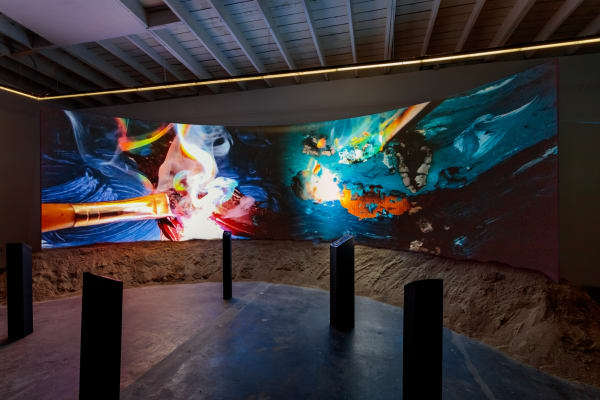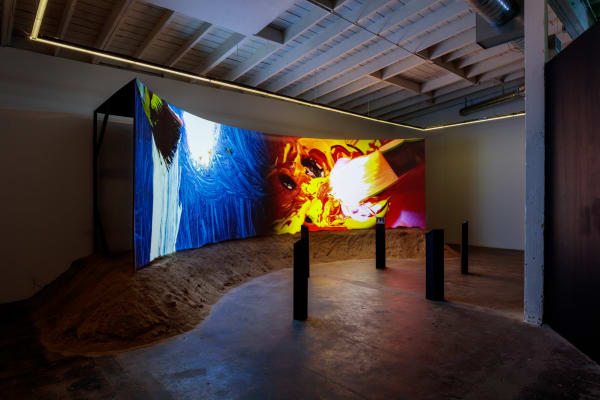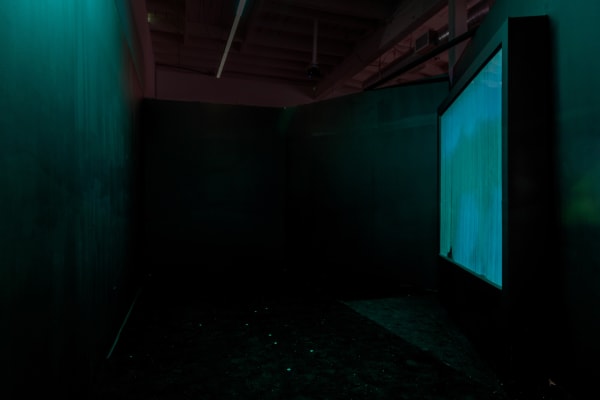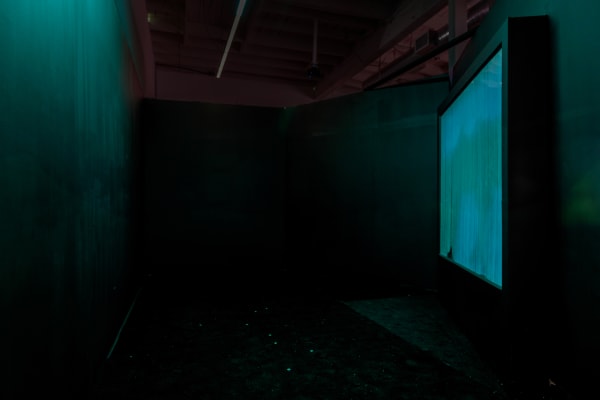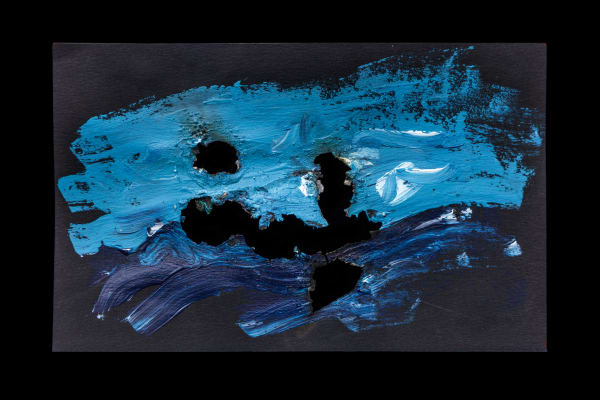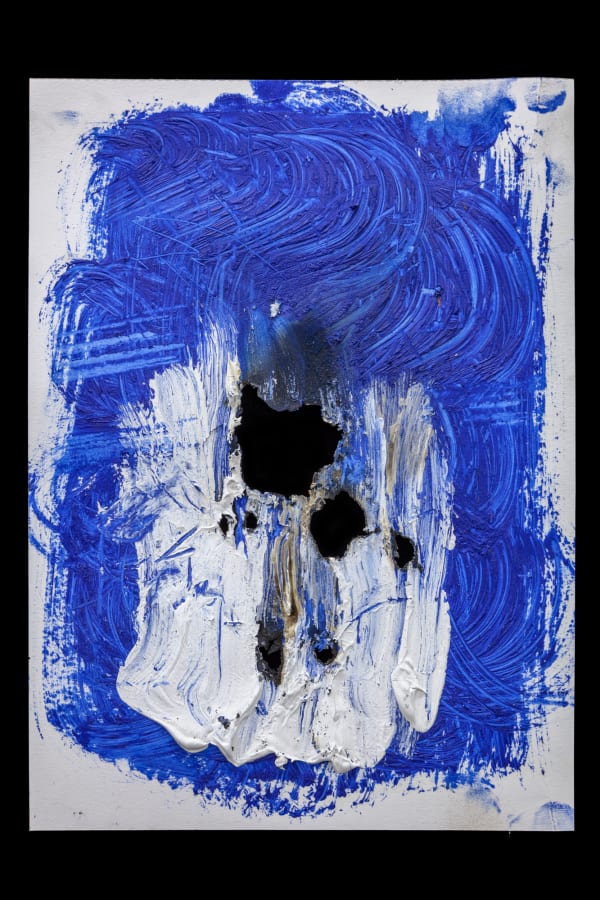Adam Tylicki: Dark Daze
“An artwork is an ephemeral notion, it has the potential to be in anything, and in nothing. One can stand in front of Miro’s Message from a Friend and feel a shudder up one’s spine, yet come back a week later and only reminisce...
Perhaps this is due in part to expectation; the art should be there, as I am here, concentrating, yet it has gone; perhaps to contextualization.
This series of performances/live-action works aim, in part, to comment on the notion of singling-out an object, the act of focusing on art — an a priori expectation.
Here, a spot light – the desert sun, aiming to illuminate, destroys what is being painted. Inherently, a collaboration between the two.”
-Adam Tylicki.
Where’s the Work?
Process and Performance in Adam Tylicki’s Practice.
With Dark Daze, Adam Tylicki reveals our blindspot. In this solo show, light performs contradictory roles, the headlamps that invite the viewers to explore in the darkness simultaneously give them the ability to blind each other. The spotlight becomes synonymous with the intent to see, and with our implicit demand for a significant experience — be it with art or entertainment or in day-to-day activities. However, as Tylicki acknowledges, the expectation placed on such an experience can prevent it from occurring. In magnifying our desire for an experience, we risk burning away the paint, the paper underneath it and eventually our ability to see at all. In this blinding light we are left with the crackling sound of fire and with sand at our feet.
Painted surfaces recur in the show’s spiraling scenography. Shaky close-up shots of a paint brush applying paint are projected on a large concave screen. The desert sun, amplified with a magnifying glass, rapidly burns holes through the paint and the paper (and even the paintbrush). We are confronted not so much with the act of painting but with the activity of burning paint. This self-effacing performance is emblematic of Tylicki’s practice as a whole. In tackling some self-imposed expectations about the experience of art, Tylicki’s artistic practice perhaps unwittingly displaces the question and discovers something else — the absurd performance of art. However, this is a sincere — that is, un-ironic — probing; it’s an impulse that demands of the viewers to reconsider his relationship to what they see and how they see it. Where is the art? In the paint? In the burn? As viewers shine their light on the matter, the projection disappears.
In Tylicki’s condensation piece we are invited to the curious prospect of watching the paint NOT drying. In a humidified wood and plexiglass case, the painting will remain wet, endlessly preserved in an unfinished state. There are distinct and at times climactic events in the condensation process which figuratively and metaphorically become the foreground of the work. Every so often, large drops of accumulated condensation roll down the inside of the plexiglass. They reward our patience by revealing narrow strips of the painting within. Shifting from being viewed at arms length, the piece draws us in close to its detail. As the artist remarks: “It’s like diving in to sea with a mask, you expect it to be this magnificent view as you drop in but in fact it’s the closer you get to everything that it becomes interesting.” Tylicki, who has a background in photography, mentions how this perceptual effect is the inverse of his experience with computer screens, in which zooming-in will eventually yield nothing but blotchy pixels.
In earlier works, Tylicki staged situations in which he attempted to draw enough attention to himself to gain access to art institutions. In Hunger Strike, he planted himself in front of a gallery, refusing to eat until he was granted a show. With Instant Curatorial Decision Tylicki pretended to spray paint the front window of a commercial gallery, eventually provoking a reaction in the person on the other side of the glass. We encounter these pieces as shaky video documentations on the artist’s website. As with the work on display in Dark Daze, they exist within a self-imposed paradox, vanishing as soon as the artist’s wish is granted.
Tylicki’s approach to media reflects the sensibility of a generation that experienced major transformations in the field of digital photography with the development of social media. The demands of instantaneous reporting have diminished the importance of the content of the image in favor of its ability to be rapidly published, accessed and exchanged. In this context, the status of the photographic and video image shifts from documentation to live testimony of an act. The performative aspect of Tylicki’s practice values the moment over its capture. Dark Daze takes us out of the photographic image altogether and brings us back to the present. What may seem like disparate artistic interventions are in fact bound by a desire for metabolic slowing. As indicated by the Daze of its title, the show is traversed by a singular, if anarchic, impulse to turn the lights down low and set up the conditions for discovery.
In conversation, Tylicki states an interest in infinity, which we may very well understand as an interest in the unfinished. His instincts lead him to work spontaneously, in an improvisatory manner — in the moment of an idea. His works perform an interruption on an assumed linearity, on a finite and perhaps wrongly pre-defined notion of what an experience should be. As we walk through the show attempting to construct a narrative, Tylicki contradicts us by forcing us back to the present moment, the non-linear infinite of contemplation and discovery.
Jasmin Blasco, Los Angeles, December 2017.
-
 Adam TylickiUntitled, 2017Video installation (color, sound), two projections, curved screen, sand
Adam TylickiUntitled, 2017Video installation (color, sound), two projections, curved screen, sand -
 Adam TylickiFigure with two pools, 2017Oil paint on canvas, wood, acrylic sheet, condensation
Adam TylickiFigure with two pools, 2017Oil paint on canvas, wood, acrylic sheet, condensation -
 Adam TylickiUntitled, 2017Acrylic paint on burnt paper with sunlight
Adam TylickiUntitled, 2017Acrylic paint on burnt paper with sunlight -
 Adam TylickiUntitled, 2017Acrylic paint on burnt paper with sunlight
Adam TylickiUntitled, 2017Acrylic paint on burnt paper with sunlight -
 Adam TylickiUntited, 2017Acrylic paint on burnt paper with sunlight
Adam TylickiUntited, 2017Acrylic paint on burnt paper with sunlight -
 Adam TylickiUntitled, 2017Acrylic paint on burnt paper with sunlight
Adam TylickiUntitled, 2017Acrylic paint on burnt paper with sunlight -
 Adam TylickiUntitled, 2017Acrylic paint on burnt paper with sunlight
Adam TylickiUntitled, 2017Acrylic paint on burnt paper with sunlight

